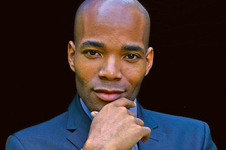A program of immortal composers Mozart, Beethoven, Schumann, and Brahms need not be all about pyrotechnics, hyped energy, and smoking instruments. As the musicians of the American Chamber Players demonstrated so ably in this performance presented by Asheville Chamber Music at the Unitarian Universalist Church such a concert of “immortal” music may as well move the heart with its forthright melodiousness, elegant shapes, and beautiful, quiet moments, as impress with its technical demands. The string players were violist Miles Hoffman, spokesman extraordinaire and the ensemble’s founder; Joanna Mauer, violin; and Stephen Balderston, cellist. Sara Stern, flute, regularly performs with the ensemble, and Reiko Uchida was the guest pianist.
Hoffman, of course, is well known to NPR radio audiences as a lively and knowledgeable commentator on classical music. His founding in 1982 of the Library of Congress Summer Chamber Festival led to the formation of the American Chamber Players. Maurer is a Juilliard graduate who performs regularly with the Metropolitan Opera Orchestra and the Metamorphosen Chamber Orchestra. Balderston, who concertizes internationally as a soloist, orchestral and chamber player and coach, is a professor of cello and string coordinator at DePaul University School of Music, Chicago, and serves as a chamber music coach for the Chicago Youth Symphony Orchestras. Stern is active as a recitalist and chamber musician, and is solo flutist with the 21st Century Consort in residence at the Smithsonian Institution in Washington, D.C. Uchida holds an Artist Diploma from Juilliard and was First Prize winner of the Joanna Hodges Piano Competition and Zinetti International Competition. She was one of the first pianists selected for Chamber Music Society Two, the Chamber Music Society of Lincoln Center’s program for outstanding emerging artists.
Twenty years separated the two works of the first half of the program. Mozart composed 4 flute quartets (Hoffman quipped that one would expect 4 flutes — right?), and this Quartet for flute and strings in D, K. 285 is considered to be the greatest of the set. By the year of its composition, 1777, Mozart had traveled to Mannheim, the instrumental mecca of eighteenth century Europe, and heard distinguished flute playing, surely an inspiration for this piece commissioned by De Jean, a wealthy Dutch amateur flutist. If Mozart had ever been resistant to composing for the flute, it’s impossible to hear it in this beautiful and elegant piece. Stern’s playing, shimmering and delicate, was a study in itself of masterful phrasing and was never overpowered by the occasional busyness in the string parts The lyrical slow movement with pizzicato strings and its transition directly into to the romp of the final Rondo was especially noteworthy.
The Beethoven Quartet for piano and strings in E-flat, Op. 16, originally written as a piano quintet with 4 winds, was reworked by the composer as a quartet for piano and 3 strings (violin, viola, and cello). Already in its first movement, an Allegro ma non troppo preceded by a slow introduction, one can hear the inheritance of Mozart coupled with Beethoven’s own experimentation with expansion of form and emotional scope. Uchida’s playing was exemplary for its clarity, variety of articulations, and seamless ensemble with the strings. The transparency of each string part was more pronounced in this work, with solo and dialogue passages deftly bringing each voice to the fore. Again, it was in the second movement Andante cantabile where there were moments of transcendent beauty, especially in the solo cello passage and later, the embellished piano melody.
The second half of the program ran the gamut of Romantic compositional norms, with 2 works sharing the common link of Clara Schumann. The exquisite miniatures of Robert Schumann (Three Romances for flute and piano, Op. 94, 1849) were composed as a Christmas present for her, and it was Clara who was the pianist in the Hamburg premiere in 1861 of Brahms’s grandiose Quartet for piano and strings in G minor, Op. 25. The Romances exemplify lyrical Schumann at his best. Uchida and Stern underscored the intimate character of each movement with consummate balance of tone and stylistic grace.
With the Brahms piano quartet came the high seriousness, experimentation, ethnic infusion, and symphonic scope lacking in the previous compositions. In the first movement alone Brahms presents idea after idea, and the charm of the music lies in part in one’s inability to predict where the piece is going. The ensemble’s interpretation of this great work was as profound as any I’ve heard and their rapport was impressive, especially given the fact that they barely fit into the configuration of the performance space and the strings were compelled to sit more or less in a straight line. One of the more stunning effects occurs in the second, the Intermezzo, where there is playing con sordino but not infrequently at a forte. The third movement was no less spectacular, an extroverted “noble” song into which is interjected a martial, dotted rhythm section which then seems to take on a life of its own. The final Rondo alla Zingarese is famous as an ethnically-inspired barn-burner, but I’ve never heard its various sections so clearly differentiated, nor its final section played as well or as fast as did these amazing players. Bravi tutti!












